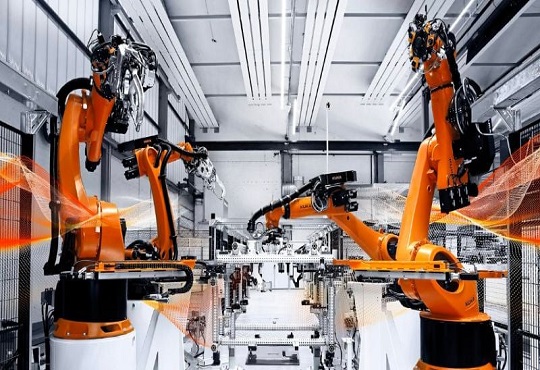The Synergy of IT and Robotic Arm Systems in Industrial Automation
Janifha Evangeline, Assistant Editor, CIOTechOutlook | Sunday, 19 November 2023, 20:47 IST

In an effort to automate its operations, retail powerhouse Amazon has initiated a trial period for deploying humanoid robots at one of its warehouses in the United States. According to The Guardian, Amazon has been reported as stating that Digit, the robot with only two legs, is capable of gripping and lifting objects. According to the outlet, the device is currently being utilized to relocate empty tote boxes within the warehouse. Nevertheless, the introduction of this robot has sparked worries regarding its impact on the company's massive workforce consisting of nearly 1.5 million individuals.
However, Tye Brady, the chief technologist at Amazon Robotics, stated that even though certain jobs may become unnecessary, the introduction of robots will also lead to the emergence of new employment opportunities.
Mr Brady said at a press conference that the company wants to "eliminate all the menial, the mundane and the repetitive," tasks inside Amazon's business.
The emergence of Industry 4.0 has initiated a fresh phase of industrial automation defined by the merging of digital technologies and physical manufacturing procedures. While industrial robot arms lie at the core of this groundbreaking transformation, as they are dynamic devices that completely revolutionize the way enterprises function and determine the course of automation in the times to come, the synergy between Information Technology (IT) and robotic arm systems plays a crucial role in advancing industrial automation. This collaboration enhances efficiency, precision, and flexibility in manufacturing and other industrial processes. Here are several key aspects of this synergy:
Data Integration and Analysis:
IT facilitates the integration of sensors and Internet of Things (IoT) devices into robotic systems. These sensors collect real-time data on factors such as temperature, pressure, and machine status. IT tools enable the analysis of vast amounts of data generated by robotic systems. Analyzing this data helps in identifying patterns, predicting maintenance needs, and optimizing production processes.
The role of industrial robot arms in gathering and evaluating data from their sensors is vital, as it enables the prediction of maintenance requirements and the improvement of production processes through optimization. Furthermore, it allows for proactive maintenance through the continuous monitoring of their performance and identification of early indicators of possible problems. This, in turn, decreases the amount of time equipment is out of service and helps to prevent expensive malfunctions.
Businesses can achieve a higher level of operational efficiency by remotely monitoring and controlling industrial robots. By utilizing centralized management and remote accessibility, organizations have the ability to monitor and coordinate various production sites from one central location.
For the purpose of automating different production processes, Tesla, the electric vehicle manufacturer, incorporated numerous industrial robot arms within its Gigafactory. Tasks such as welding, painting, and assembly are carried out by these robots. Tesla achieved a notable enhancement in production efficiency, defect reduction, and product quality through the utilization of robots. Furthermore, worker safety was enhanced through the automation of perilous tasks as a result of its implementation.
California-based Rapid Robotics has specialized in producing case palletizing solutions. The company develops an all-inclusive palletizing solution capable of managing several SKUs and pallet patterns on one production line. These robotic arms can be utilized in various scenarios such as packing items, performing multiple steps in machine operation, as well as loading.
Cybersecurity & Remote Monitoring and Maintenance:
IT professionals play a vital role in securing robotic systems from cyber threats. As more devices become interconnected, ensuring the cybersecurity of these systems becomes paramount to prevent unauthorized access and protect sensitive data. Implementing strong authentication methods and encryption protocols is essential to safeguard communication between robotic arms and the central control systems.
IT enables remote monitoring and maintenance of robotic systems. This allows engineers and technicians to diagnose issues, update software, and perform maintenance tasks without being physically present on the factory floor. Through data analytics and machine learning algorithms, IT contributes to the development of predictive maintenance strategies, reducing downtime and increasing the lifespan of robotic systems.
Stryker (SYK) manufactures a diverse range of medical equipment, which includes machines used in surgery that are assisted by robotic arms.
Dr Joe Smith, Senior Research Associate in the School of Electrical, Electronic and Mechanical Engineering at the University of Bristol said: “We couldn’t have performed this experiment using standard lab components, so we decided to look into robotics. We’ve shown that robotic arms are mature enough to navigate very complex settings.
Human-Robot Collaboration:
IT plays a role in designing user interfaces that enable seamless interaction between human operators and robotic systems. This includes the development of intuitive control panels and integration with Augmented Reality (AR) or Virtual Reality (VR) systems. IT contributes to the advancement of collaborative robotics, where robots work alongside humans. This involves developing algorithms that ensure safe and efficient cooperation between human workers and robotic arms.
BMW, the car manufacturing company, introduced industrial robot arms into their manufacturing process to handle tasks like welding, painting, and assembly. The robots and human workers collaborate together, improving productivity and accuracy. BMW has achieved higher production standards, decreased the time it takes to complete tasks, and enhanced the efficiency of using resources by incorporating robotic arms.
Cobots, also referred to as collaborative robots, are manufactured by Universal Robots based in Odsense, Germany. The company offers automation solutions through the creation of adaptable collaborative robotic arms for the purpose of enhancing production efficiency and boosting precision.
“Getting robots to help make heavy machinery is necessary because of the growing labor costs and lack of people, for example, skilled in arc welding,” stated Jyrki Latokartano, chairman of the Robotics Society in Finland.
The synergy of IT and robotic arm systems in industrial automation not only improves efficiency but also opens the door to new possibilities in smart manufacturing, where adaptive and intelligent systems can respond to dynamic production environments.




